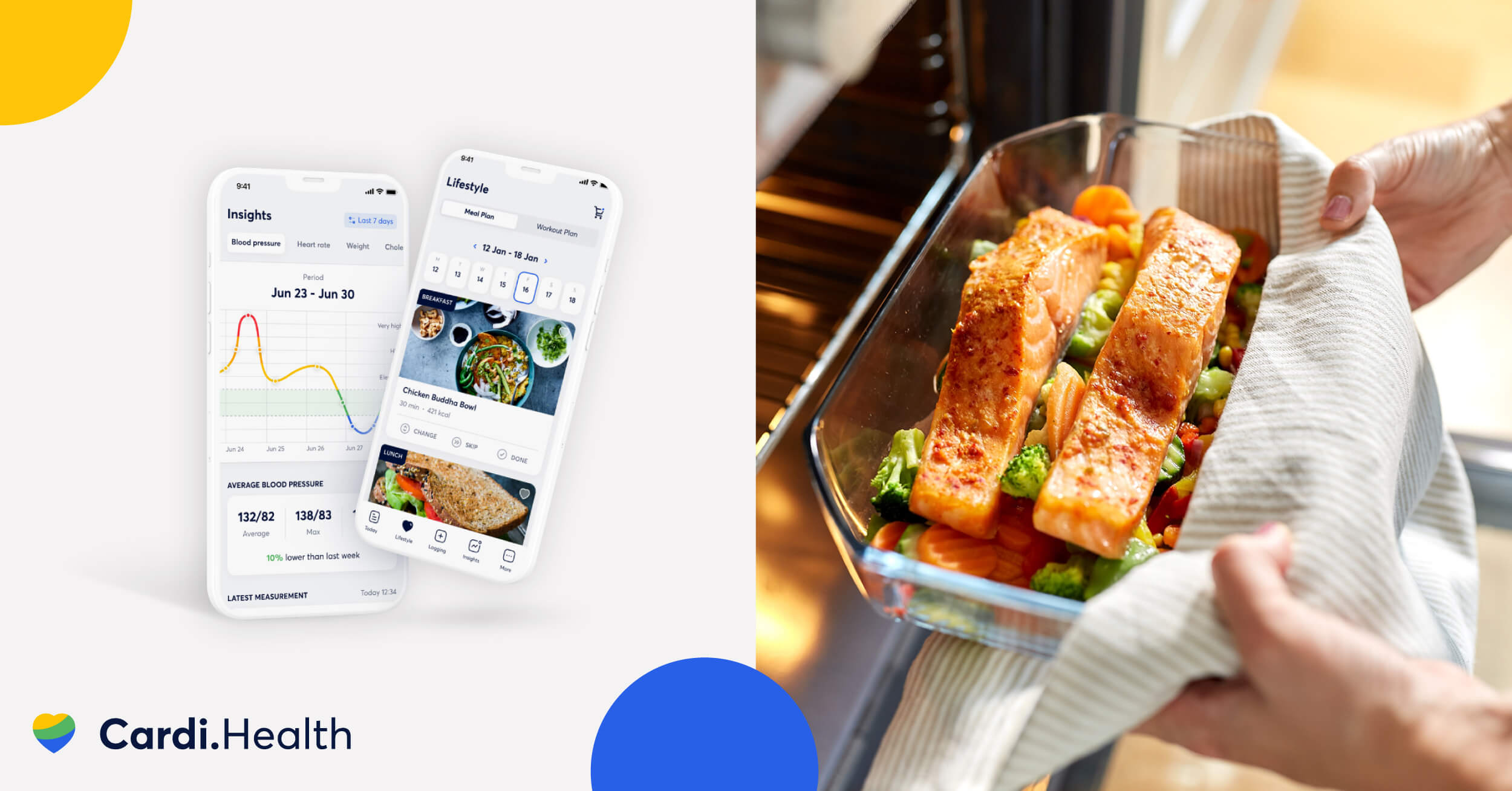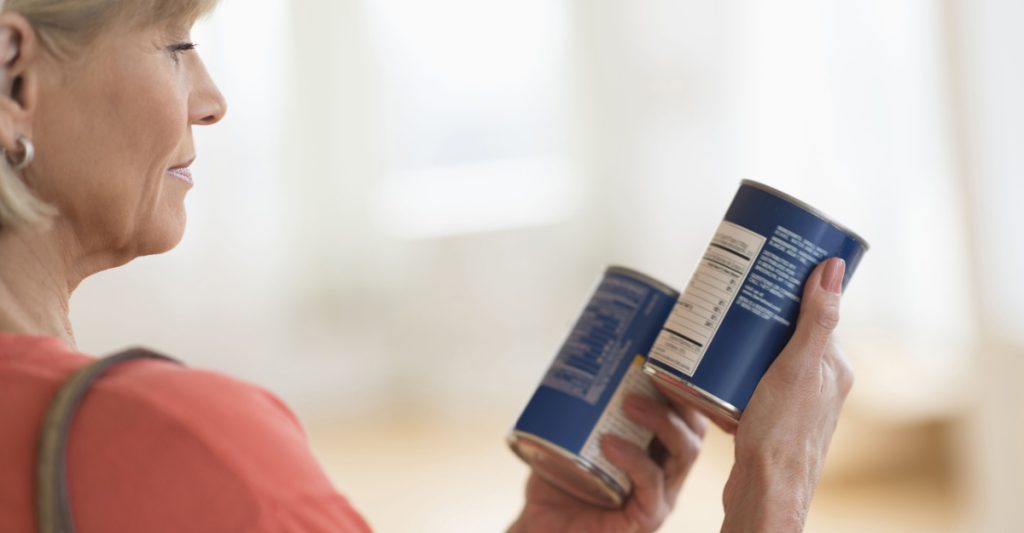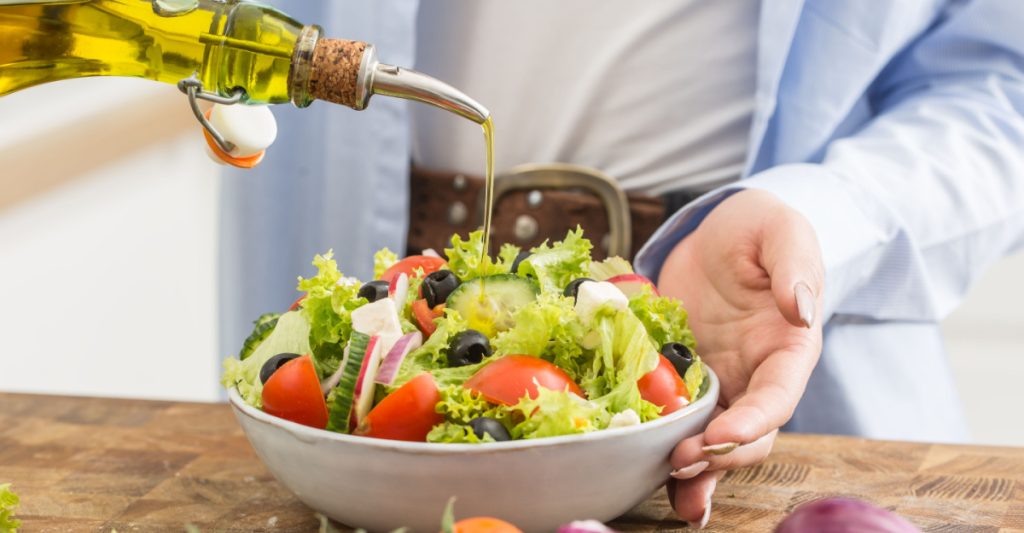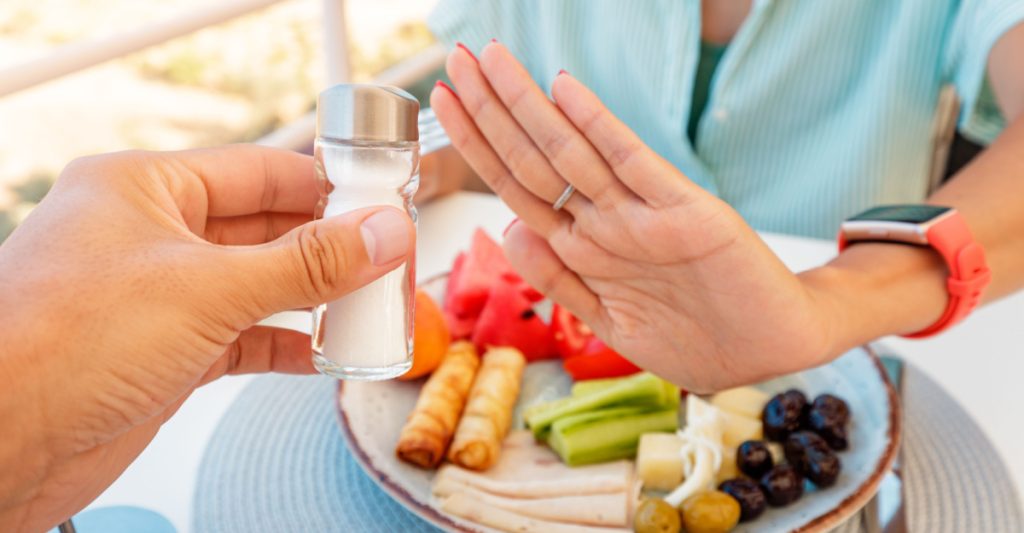According to the Centers for Disease Control and Prevention, 9 out of every 10 Americans over the age of 2 have too much sodium in their diet!
By incorporating more low-sodium foods into your diet, you can lower your blood pressure (BP). Reducing salt can be hard without any help, though.
Don’t worry. This guide will tell you about sodium intake and high blood pressure, how much sodium per day with high blood pressure patients, and how you can move to lower sodium foods.

Master your heart health now
Take part in our 60sec quiz and get a heart health plan tailored just for you.
Contents
How Does Sodium Affect Blood Pressure?

The primary source of sodium is salt. Salty foods put more sodium in your blood vessels. Sodium particles pull water in, which makes the body retain water in the blood vessels.
More blood running through the blood vessels will raise blood pressure. That’s how high-sodium foods impact your BP.
The average person should stay under 2,300mg of sodium daily. For someone with high blood pressure, the target should be less than 1,500mg per day.
Too much sodium can have ill effects besides high blood pressure (which can predispose to heart attacks and stroke). It can also lead to kidney disease, stomach cancer, and loss of bone density.
Start managing your heart health now!
Find out what works for you with this 60sec quiz.

What Is a Low-Sodium Diet?
A low-sodium diet contains less than 3,000mg of sodium consumed daily. However, some sources may go as low as 2,000mg of sodium per day.
While a teaspoon of table salt has 2,300mg of sodium, the salt shaker is not where most of your salt comes from. Most comes from packaged and processed foods.
Food labels will show you how much sodium you’re eating. The percentage beside it shows how much of your daily recommendation is in one serving. Anything above 20% is a high-sodium food.
Here are some common foods with a lot of salt:
- Pizza
- Burgers
- Snacks like chips and crackers
- Burritos
- Sandwiches with deli meats
- Canned soups
Benefits of a Low-Sodium Diet for High Blood Pressure
With high blood pressure, low-sodium diet modifications can prevent your body from retaining fluid. Normal blood volume makes it easier to have lower or normal blood pressure.
A low-salt diet has been proven to lower blood pressure by as much as 11.5mmHg in people with hypertension. It also provides additional health benefits, like a lower likelihood of kidney disease, stroke, and heart failure.
How to Follow a Low-Sodium Diet?

Less sodium can mean lower blood pressure, but trying to reduce salt in your diet can be tough. Here are some useful tips.
Reduce sodium intake gradually
Suddenly cutting salt out can make your food taste bland. Instead, attempt to eat less sodium each week. After 3 or 4 weeks, your diet’s sodium content will have dropped significantly.
Eat less cured and processed meats like sausages and ham. When buying canned vegetables and other foods, look for “low sodium” or “no salt added.”
Substitute high-sodium foods
Some of your favorite foods are high in salt. Substitute these for their low-sodium versions to enjoy them without their downsides.
- Fresh or frozen lean meats instead of cured or processed meats
- Alternatively, low-sodium canned meat
- Canned vegetables without added salt instead of those with salt
- You can also opt for fresh vegetables or frozen vegetables
- Unsalted chips, crackers, and popcorn
- Unsalted nuts
- Low-salt soups and broths
Cooking tips
How do you cook meals without salt? Adding salt gives a lot of recipes taste.
There are different ways you can season food without salt, or you can use salt substitutes.
- With lean meats, don’t add salt, but use the right seasonings. Opt for curry powder, lemon juice, pepper, marjoram, garlic, onion, sage, thyme, and others.
- Make your vegetables taste better by adding things like vinegar, lemon juice, garlic, pepper, onion, basil, and oregano.
- Salt substitutes work if seasonings alone don’t cut it for you. Products like NoSalt, Morton’s Salt Substitute, and Dash Salt-Free Seasonings can help food taste salty without sodium.
Examples of a Low-Sodium Meal Plan
Meal planning can save you stress when eating at home. It is less likely for you to obey unhealthy cravings and gives you a healthy schedule.
Here’s a basic low-sodium meal plan that will help lower blood pressure and keep your heart healthy.
- Breakfast: Yogurt Parfait
- 6 ounces of fat-free yogurt
- 1 ounce of granola
- 1 cup of blueberries or other fruits
- 1 tablespoon of unsalted nuts
- Lunch: Beef Sandwich
- 1 whole wheat bun or 2 slices of whole wheat bread
- 3 ounces of roast eye of round
- 1 cup of steamed vegetables
- 1 tablespoon of low-sodium BBQ sauce
- First snack: A handful of unsalted sunflowers seeds
- Dinner: Roasted Chicken and Potatoes
- 3 ounces of roasted chicken breast
- 2 small baked or boiled potatoes
- 1 cup of green beans
- 1 teaspoon of unsalted butter
- 1 cup of blackberries or raspberries
- Second snack: 3 cups of unsalted, air-popped popcorn
Of course, it is important to have low-sodium recipes and meal plans that your taste buds like.
The good thing is some apps can get your food preferences and put together a personalized meal plan.
Cardi Health will ask you about the foods you eat, your allergies, foods you don’t like, how many times you eat in a day, and more. It uses these to calculate and construct the perfect meal plan for you.
Start managing your heart health now!
Find out what works for you with this 60sec quiz.

Reading Food Labels for Sodium Content

The “Nutrition Facts” label on foods can show you how healthy they are at a glance. At the very top, you will see how many servings the package has and the size of a single serving.
All the values below, including sodium, are about one serving.
The sodium row will show you the sodium content in milligrams and how much each serving contributes to your daily requirement of sodium as a percentage.
- < 5% is low sodium
- > 20% is high sodium
Eating Out on a Low-Sodium Diet
You can control salt intake with groceries and home-cooked meals, but what about restaurant food?
Foods cooked with table salt (sodium chloride), monosodium glutamate (MSG), and soy sauce can add extra salt to your diet.
Here are some tips to avoid too much salt in restaurant dishes:
- Check online to see if your restaurant publishes the nutritional values of their meals.
- Make a special request for your meals to be made salt-free. You can bring your own salt substitute.
- Opt for baked or roasted lean meats instead of fried, sauced, or battered options.
- Ask for salad dressing to be served on the side so you can control your sodium intake.
Incorporating Exercise Into a Low-Sodium Lifestyle
Working out regularly can stop hypertension from getting worse. It has even been shown to decrease BP with hard-to-treat hypertension.
When you exercise heavily, you lose sodium in your sweat. This is why sports drinks like Gatorade have sodium in them. This can help reduce the effect of sodium in your body but don’t push too hard because your body still needs some.
- If you’re not active, it can be hard to start exercising. Brisk walking is a good starting point.
- Choose an exercise you enjoy, like cycling, jogging, swimming, or hiking.
- Don’t push yourself too hard at the beginning. Ease into it.
- If possible, get a friend or two to join you in working out. Makes it fun and easier to stay consistent.
Cardi Health can provide a personalized exercise plan to help you control your BP and even combat weight gain in the process.
Managing High Blood Pressure Beyond a Low-Sodium Diet

A salt-free diet is one way to tackle high blood pressure. Other options can be just as effective.
- Other dietary approaches: The Dietary Approaches to Stop Hypertension, or DASH, diet, is proven to reduce blood pressure. It’s the best diet for high blood pressure. Besides reduced sodium intake, it encourages eating more fresh fruits, vegetables, low-fat dairy, whole grains, and lean meats. The DASH diet also recommends that you eat less saturated fat, added sugars, and red meat.
- Stress management: There’s a solid link between stress and increased blood pressure. Proper stress management techniques can help immensely.
- Getting good sleep: When we sleep, our BP goes down, so staying awake for a long time means our BP stays up. Sleeping well can help manage hypertension, but also keep other health conditions away.
- Antihypertensive medication: Lifestyle changes can do a lot for stage 1 hypertension, but in stage 2, medication is usually needed. Of course, the right medication can bring blood pressure down very effectively.
Common Misconceptions About Low-Sodium Diets
There are a lot of myths about low-sodium diets, so it is time to bust some of those.
- Myth #1: A low-sodium has essentially zero sodium. This isn’t true. Your body needs sodium. For someone with hypertension, anywhere less than 1,500 mg of sodium is a great target.
- Myth #2: Low-sodium diets are only for people with hypertension or heart disease. A low-sodium diet can be helpful for healthy people, too. It can reduce the chance of developing high blood pressure.
- Myth #3: Sea salt is more healthy than table salt. Both forms of salt are mostly sodium chloride, so there’s no difference in their sodium content.
- Myth #4: Not salting your meals is enough. 70% of your dietary sodium comes from processed foods and not table salt.
Tips for Long-Term Success With a Low-Sodium Diet

It can be hard to stick to a low-sodium diet in the long run. Some tips can make this easier for you.
- Lean into potassium-containing salt substitutes: If you can’t let go of the taste salt provides, salt substitutes with potassium are a great trade, plus they can counteract the effect of the sodium you do eat.
- Use an app: Following a low-sodium diet can become easier when you don’t have to plan meals yourself. Cardi Health can plan your meals for you and help you keep track of your blood pressure trends.
- Keep track of your BP and visit your doctor regularly. This can make your new diet’s impact evident, which can be a great motivator.
- Go for low-sodium versions of your favorites: Many foods you like might have a lot of sodium. Instead of depriving yourself of them, just opt for the versions with little sodium.
- Eat more fruits to satisfy cravings: Hunger can make you more likely to grab a bag of chips. Instead, fill up on fresh fruit to send the hunger away.
Start managing your heart health now!
Find out what works for you with this 60sec quiz.

FAQ
How does sodium influence blood pressure?
Sodium pulls water into blood vessels, causing retention and raising blood pressure.
What defines a low-sodium diet?
Typically, it’s a diet with less than 3,000mg of sodium daily but can be as low as 2,000mg.
Why are low-sodium diets beneficial for high blood pressure?
They reduce fluid retention, helping lower or maintain normal blood pressure.
How can I ensure a low-sodium meal when eating out?
Check online nutritional values, request salt-free dishes, and choose baked or roasted over-fried options.
Low-Sodium Diet for High Blood Pressure: Key Takeaways
Reducing the sodium in your diet reduces your body’s fluid retention, which reduces your blood pressure. Most of the salt you eat comes from processed foods and not the dinner table, so you should check the nutritional info provided by food manufacturers.
Make efforts to consume less salt, and you’re bound to see it not just with your blood pressure but with other aspects of your help. A lifestyle change like this puts your health into your hands, so do your best!
Related articles
Best Foods to Lower Cholesterol
Does Caffeine Raise Blood Pressure?
Does Drinking Water Lower Blood Pressure?
Causes of High Blood Pressure at Night
10 DASH Diet Breakfasts for a Healthy Start
Heart-Healthy Diet Guide
What Should an 85-Year-Old Blood Pressure Be?
What is Normal Blood Pressure for a 70-Year-Old?
How to Read Blood Pressure: A Comprehensive Guide
Manage your heart health now
Find out what works best for you with this 60sec quiz and get your personalized heart health plan.

